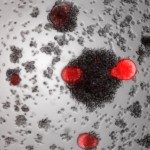Lien vers Pubmed [PMID] – 12097602
J. Virol. 2002 Aug;76(15):7883-9
We constructed a chimeric human T-cell lymphotropic virus type 1 (HTLV-1) provirus in which the original envelope precursor sequence was replaced by that of ecotropic Moloney murine leukemia virus (Mo-MuLV). Chimeric particles produced by transient transfection of this chimeric provirus were infectious for murine cells, such as NIH 3T3 fibroblasts, lymphoid EL4 cells, and primary CD4(+) T lymphocytes, whereas HTLV-1 particles were not. The infectivity of chimeric particles increased 10 times when the R peptide located at the carboxy terminus of the MuLV envelope glycoprotein was deleted. Primary murine CD4(+) T lymphocytes, infected by the Delta R chimeric virus, released particles that could spread the infection to other naive murine lymphoid cells. This chimeric virus, with the Mo-MuLV envelope glycoprotein and the replication characteristics of HTLV-1, should be useful in studying the pathogenesis of HTLV-1 in a mouse model.

